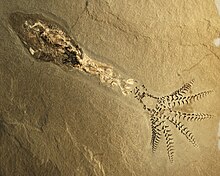Phragmoteuthis
| Phragmoteuthis Temporal range:
| |
|---|---|
| Scientific classification | |
| Kingdom: | Animalia |
| Phylum: | Mollusca |
| Class: | Cephalopoda |
| Order: | †Phragmoteuthida |
| Family: | † |
| Genus: | †Phragmoteuthis Mojsisovics, 1882 |
| Species | |
| |
| Synonyms | |
| |
Phragmoteuthis is a genus of extinct coleoid cephalopod known from the late Triassic[1] to the lower Jurassic.[2] Its soft tissue has been preserved; some specimens contain intact ink sacs,[1] and others, gills.[3] It had an internal phragmocone[1] and ten arms.[4]
Previously described species, P. conocauda and P. montefiorei got their own genus, .[5]

Clarkeiteuthis conocauda, a species previously considered to belong to this genus
References[]
- ^ a b c Doguzhaeva, L.; Summesberger, H.; Mutvei, H.; Brandstaetter, F. (2007). "The mantle, ink sac, ink, arm hooks and soft body debris associated with the shells in Late Triassic coleoid cephalopod Phragmoteuthis from the Austrian Alps". Palaeoworld. 16 (4): 272–284. doi:10.1016/j.palwor.2007.08.002.
- ^ Mutvei, H.; Donovan, D.T. (2006). "Siphuncular structure in some fossil coleoids and Recent Spirula". Palaeontology. 49 (3): 685–691. doi:10.1111/j.1475-4983.2006.00533.x.
- ^ Reitner, Joachim (11 November 2009). "Preserved gill remains in Phragmoteuthis conocauda (Quenstedt, 1846-1849) (Toarcian, Southern Western Germany)" (PDF). Berliner paläobiologische Abhandlungen. 10: 289–295. Archived from the original (PDF) on 20 March 2012. Retrieved 22 February 2011.
- ^ Donovan, D.T. (2006). "Phragmoteuthida (Cephalopoda: Coleoidea) from the Lower Jurassic of Dorset, England". Palaeontology. 49 (3): 673–684. doi:10.1111/j.1475-4983.2006.00552.x.
- ^ Fuchs, Dirk; Donovan, Desmond T.; Keupp, Helmut (2013-12-01). "Taxonomic revision of ?Onychoteuthis? conocauda Quenstedt, 1849 (Cephalopoda: Coleoidea)". Neues Jahrbuch für Geologie und Paläontologie - Abhandlungen: 245–255. doi:10.1127/0077-7749/2013/0368.
Categories:
- Belemnoidea
- Jurassic cephalopods
- Triassic cephalopods
- Mesozoic cephalopods of Europe
- Belemnites
- Prehistoric life of Europe
- Late Triassic first appearances
- Early Jurassic extinctions
- Prehistoric cephalopod genera
- Prehistoric cephalopod stubs
